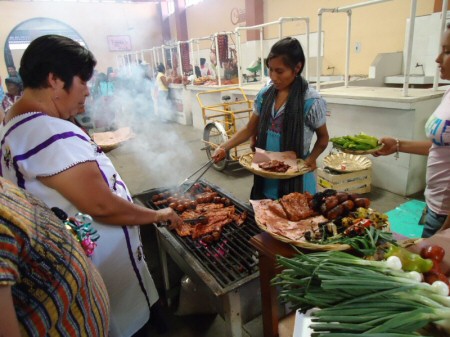
Tlacolula Market
|

Tlacolula Market |
It's the violence outside of Mexico which seems to be on the rise (not to discount the casualties in President Calder&joacute;n's war against drugs and the cartels, and the gravity of matters in and around certain Mexican cities), yet the Mexico fear-mongering continues at a fervent pitch.
A major daily newspaper's online version included these eight, separate headlines (including dropdown articles) on November 6, 2011:
These stories appeared not in a Mexico City newspaper, not in a Mexican city noted for violence where the Sinaloa cartel maintains a presence, and not in Oaxaca, which contrary to the belief of many has been virtually incident-free in terms of harm or violence towards tourists - of course there is the odd incident, as in any other city of comparable size. The foregoing headlines appeared in The Toronto Star.
I wrote about The Toronto Star four years ago, noting five stories with headlines indicating violence - violence in that Canadian city, not in a Mexican metropolis (http://oaxacadream.com/articles/tourist21.html). I subsequently updated the article, looking at online versions of the newspaper for two dates in 2009, with headlines reflecting three violent crimes for each date. And then finally in 2010 in one edition of the same newspaper I noted seven headlines centering upon violent incidents in the Greater Toronto Area.
And here we are, as 2011 closes out, if not with an escalation of violent crimes being perpetrated in Toronto, then little if any reduction in the incidents of violence (at least reported). Yet in Cuidad Juárez, often identified as a hotbed of drug wars and violence given its location right on the U.S. border, homicide rates dropped 68.6% from October 2010, to May 2011 (Mexico's ministry of public security).
Thankfully the travel advisories relating to drug wars and violence in Mexico are now, finally, more location specific than previously. But the naysayers keep coming out of the woodwork, trying to paint all of Mexico with one broad stroke of the brush. The fact is that the majority (70%) of homicides during 2010 were committed in seven of Mexico's 31 states. Oaxaca, for example, has not been overtaken by the Sinaloa cartel, or any Mexican or other drug cartel. Expats and Mexican nationals alike continue to move to Oaxaca.
If I didn't feel as safe or safer living in Oaxaca now, as I did spending most of my live in Toronto, I would have high-tailed it to back to the land of hockey and Northern Lights in the wake of Oaxaca's 2006 civil unrest. Even those few months did not result in a wholesale exodus of Mexicans or expats out of fear.
I won't repeat the names of the cities to which I would dare not venture (though one Mexican city has already been noted), or even the stretches of highway accessing those cities. They do exist. Surely even President Calderón would not recommend that tourists visit certain areas in Mexico at this point in time because of drugs and violence.
The following cities each bear witness to incidents of violence, drug-related deaths, and even the odd tourist casualty from time to time: New York, Montreal, Paris, Rome, Toronto, Chicago, London, Sydney, LA, and the list goes on.
The following Mexican cities, and tens of others like them, are essentially as safe if not safer than the foregoing international centers of cultural and commerce: San Miguel de Allende, Cancun and the Riviera Maya, Puerto Vallarta, Huatulco, Oaxaca, Mérida, San Cristóbal de las Casas, Puerto Escondido, Mexico City, Puebla, Ajijic, Lake Chapala, etc, etc, etc.
The main tourist destinations for U.S. and Canadian citizens are geographically far removed from the very specific areas that have of late been significantly affected by crime in Mexico, primarily along the U.S. - Mexico border. For example, the distance between the border and Puerto Vallarta is over 800 miles. It's almost the same distance between Oaxaca and Nuevo Laredo (the Mexican city bordering Laredo, Texas). And the more southern Mexican tourist destinations are even further away from the U.S. border and Mexican cities noted for violence and drug wars. The distance between Cancun and Ciudad Juárez is about the same as between New York and Miami.
Take a look at your own big - city newspaper, and then ask if Mexican and other international journalists should caution prospective tourists about drug gangs and violence in your hometown. Should the Mexican government begin issuing travel advisories against vacationing in Fort Lauderdale, Orlando and Daytona Beach, because of murders in South Miami? What about shunning travel to Chicago and other major American and Canadian cities because of drug trafficking and violence in and near public housing developments?
Statistics of homicides per 100,000 per capita in the 20 most densely populated cities in the Americas, recently published by the United Nations Office on Drugs and Crime, indicate that you're more likely to be a victim of homicide in Detroit, Washington and Chicago, than in Mexico City. Mexico City ranks about the same as Houston, with Philadelphia, Miami and San Francisco ranking close behind. It's time to rethink unfounded fears and do your own research before outright discounting travel to a Mexico tourist destination.
Alvin Starkman is a paid contributing writer for Mexico Today, a program for Marca País - Imagen de México. Mr. Starkman is under a contractual obligation to write in a factual, truthful and verifiable manner within the context of stating reasoned opinion. Mr. Starkman has written over 230 articles about life and cultural traditions in Oaxaca, including essays about the 2006 Oaxaca civil unrest, and Mexican legal reform.